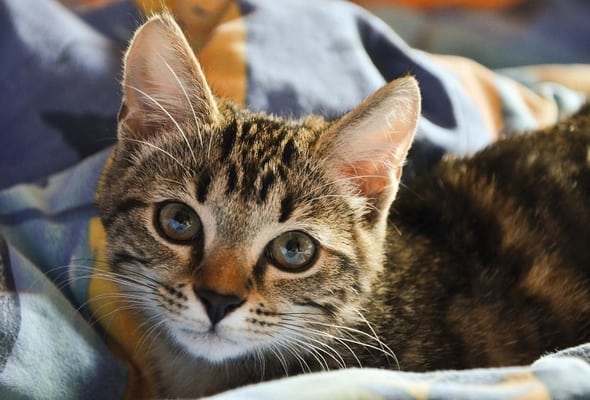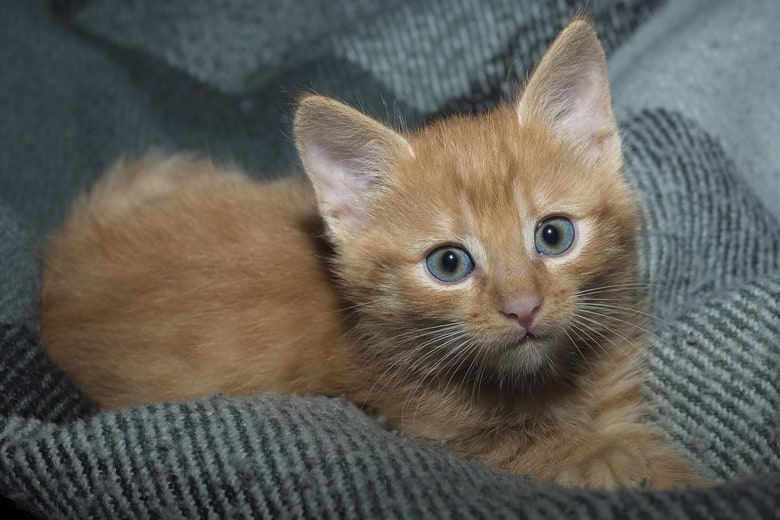When your kitten is first born, they are extra fluffy. Cute compact little fluffballs with downy coats that are soft to the touch. Their coats can have an almost cotton candy-like texture and appearance. Your kitten’s fur is doing the job of keeping their tiny body insulated from heat and cold.
As the months go by, your kitten will lose its baby fur and the look, texture, and maybe even markings on their coat will change. A kitten will also begin to shed more. This change is a clue that your kitten is entering the adolescent stage of its life.
When Do Kittens Lose Their Baby Fur?
A kitten begins to lose their baby fur when they are between 6-12 months old. This is when kittens enter their adolescence stage. Once they have reached the age of adolescence, their once downy coats will begin to shed and their adult or permanent coat begins to grow in.
During this time is when your kitten may begin shedding more and you may notice little tufts or tumbleweeds of fur around your home. Don’t be alarmed, this is perfectly normal.
This is when it would be good to introduce grooming into your kitten’s care routine to help with loosening the shed hair and prevent it from getting all over your furniture.
If you notice that your kitten has bald patches or is losing clumps of fur, you will want to contact your vet. Losing chunks of fur all at once is not typical and there may be an underlying issue.
Does a Kitten’s Fur Change as They Get Older?
A kitten’s coat is typically shorter, softer, and not as shiny as an adult cat’s coat. For tabby cats, generally the darker the markings at birth the more defined they will be in adulthood.

If your kitten is a tabby they may have been born with lighter or even white fur and their markings will darken as they reach adulthood. Cream kittens can be born with markings that grow lighter as they age.
White kittens are sometimes born with black markings on their head that can completely disappear once they are adult cats. Fur patterns don’t typically change. They simply become more or less defined depending on the breed of a cat or the length of their fur.
When your cat enters its senior years you may start to notice new changes in their fur. Cats can grow gray hairs just like humans do. Depending on the color of your cat this may or may not be noticeable. Gray hair is more noticeable in black haired cats.
What Is the Difference Between Kitten and Cat Fur?
A lot of the differences between kitten and cat fur are visible to the naked eye: a kitten’s coat is shorter, softer, and less shiny. While a cat’s coat is typically shinier with a more silky feel to it. Cats have what are called compound follicles.

Which means each of their hair follicles can grow as many as twenty hairs. Humans can only grow one strand of hair per follicle. All cats, regardless of age, have four types of hair. The four types are broken down into these categories:
1. Vibrissae are your cat’s whiskers! You will find these on your cat’s muzzle, cheeks, above their eyes and even on the outer parts of your cat’s legs. Whiskers are sensory organs that help your cat navigate. They are especially helpful with helping your cat navigate in darkness and gauge the size of openings.
2. Guard hairs are your cat’s long, glossy outer coat. It repels dirt and moisture. Guard hairs also determine your cat’s color.
3. Undercoat or down hair is the shorter, denser hair that lies under guard hairs. This is your cat’s insulating layer that helps regulate your cat’s body temp and protect it from heat loss. Certain breeds of cats do not have down hair, while others like the Devon Rex only have down hair.
4. Awn hairs are common in cats but uncommon in most other mammals. It is the secondary layer of hair and is thinner than guard hair. It is an additional layer of insulation. Most of your cat’s visible coat is made up of awn hairs.
Do Kittens Shed Less Than Cats?
Yes. Though kittens can shed it is not usually much. If your kitten begins to shed regularly this is typically a sign that they are reaching their adolescent phase. The kitten fur will begin to fall out to make way for the adult coat.
The shedding will be accompanied with changes to the appearance and texture of your kitten’s fur.
As your cat ages grooming will become a more important part of keeping their shedding under control. If your kitten is extra fluffy (or a long-haired breed), grooming them young will help them get used to the process when they are older.
Adolescent and adult cats shed daily, but also go through one to two major sheds a year. This is generally around spring as they lose their winter coats and fall as they grow a thicker, warmer coat for winter. If your cat is an indoor-only cat, their shed pattern will be more steady.
How Can You Tell if Your Kitten Will Be Fluffy?
The first answer to the mystery of how fluffy your kitten will be is to know your kitten’s breed. If your kitten is a Persian, Maine Coon, or Himalayan then the answer is, your kitten will be very fluffy.
Outside of this concrete evidence you will need to be patient and wait to see what the physicality of your kitten will be.
It can take between 8-12 weeks to truly know what the length of a kitten’s fur will be. By this point hair length should be visible. Another tell-tale sign is to look at the fur between your kitten’s paws.
Long haired kittens tend to have long tufts of fur between their toes. You will also notice longer tufts of fur around your kitten’s ears. All of these are clues that you have yourself a long-haired kitten.
Conclusion
Watching your kitten grow and change can be great fun. Knowing what to look for when the big change of adolescence approaches can help you be prepared. So if you notice your kitten is beginning to lose its baby fur, grab a brush and a lint roller and enjoy!

